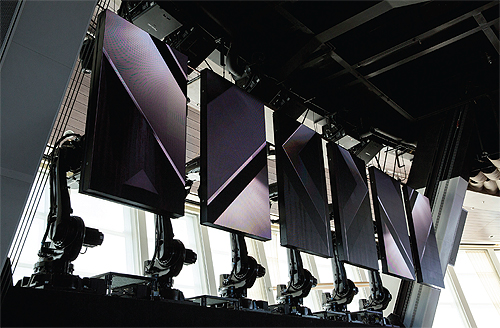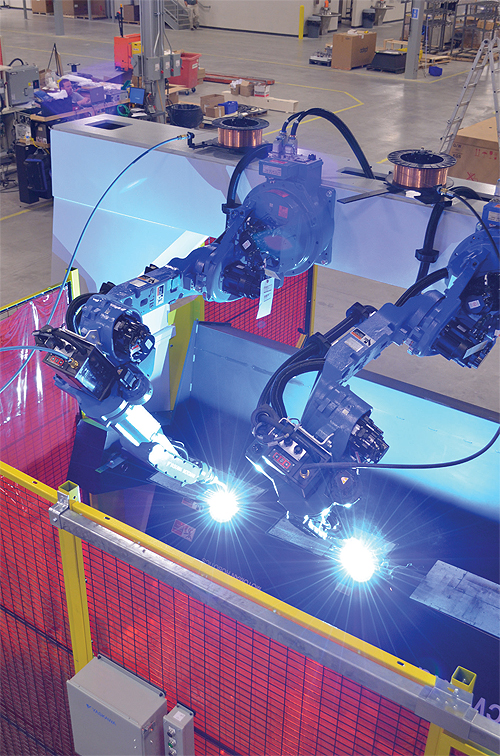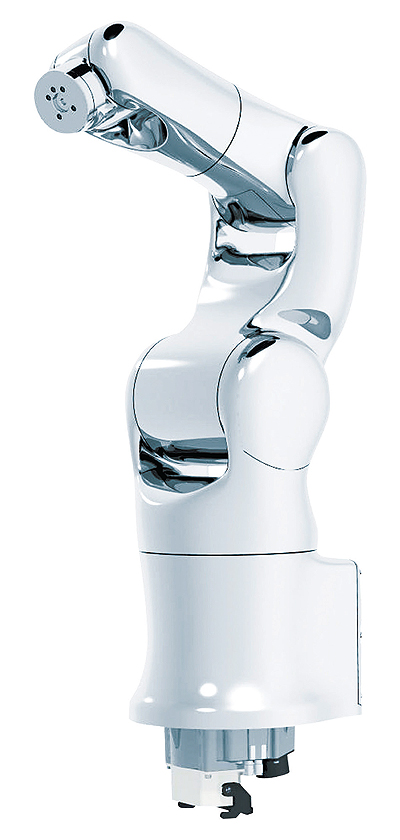by Lisa Eitel, Senior Editor, @DW_LisaEitel—
In today’s advanced manufacturing environment, it would be hard to find a production facility that hasn’t implemented robotics in some process or other. That’s according to Skye Gorter, automation specialist at Cowper Inc. “Robotics have had tremendous impact on manufacturers’ ability to get higher repeatability, precision, and throughput, as well as a safer working environment—all while reducing the cost to produce the same products,” said Gorter. The benefits are clear, but what’s behind the rise of robotics in automation?
“Better microchips have vastly improved processing power at lower costs, so designers are implementing robotic kinematic structures at the motion-control level for seamless integration of robotics into the overall machine system,” said Gorter. So, coupled with more efficient and simpler-to-use serial buses, such as EtherCAT, the performance of industrial robotics is making a giant leap forward in the manufacturing process.
The trend for end users to incorporate robotics has also gained momentum thanks to increased availability of robotic platforms—not just Cartesian, but also Delta and six-axis selective-compliance-articulated robot arms (SCARAs) or gantry-style Cartesian robots. That’s according to Mike Everman, principal and chief technology officer at Bell Everman. Most industrial robots for machine tending, palleting and welding are SCARAs or gantries made of linear power-transmission components moved by motors.

One caveat here: Though Cartesian robots are often less expensive than SCARAs or Delta robots, that isn’t always the case. “That’s because if a Cartesian robot has four axes with separate drives and a PLC as the brains, for example, a controls engineer must program and coordinate those axes to get the end effector to move from A to B in a fluid way. With a SCARA, the engineer plugs an X-Y-Z point in space into the system and lets the robotic controller figure out the trajectory,” said Jeff Henshaw, controls engineer at Yamaha Robotics.
That said, some finished Cartesian robots or stage setups can handle the same jobs as Delta or SCARA robots for much less cost and programming effort. “In recent years, engineers have become particularly enamored by the elegance and fluidity of Delta and SCARA robots,” said Everman. “However, Delta and SCARA robots have cost and ease-of-control disadvantages compared to Cartesian robots. As engineers evaluate the cost and control factors, a natural step is to look at Cartesian and other pre-engineered systems as an alternative.”
Cartesian robots can take commands from a PLC, the workhorse of the factory floor…and the cost-per-payload favors Cartesians as well. “Most Delta machines are for fairly light use, whereas general factory automation often needs more robust equipment capable of heavier payloads,” said Everman.
Deltas and Cartesians also have an advantage over SCARAs in that they take up less space for a given reach, added Everman. A SCARA essentially has a circular access area, with dead space in the corners of its bounding box.

No matter the kinematics, another technological advance that’s improved the performance of industrial robotics in recent years is integrated safety that monitors robot speed, position and torque, as well as the status of external barriers. That’s according to Alex Bonaire, product manager at Mitsubishi Electric Automation. These safety systems let engineers deploy robots in more diverse environments than previously possible—for robots that work alongside humans, for example.<
“Over the past several years, end users in consumer-electronics and warehouse-management industries have driven many robotics manufacturers to develop products, as their needs are rather unique from the majority of robotics consumers,” said Bonaire.
Technological advances have also put robots into new applications. “Advances in controls and software have made integrating robotics easier and more cost effective…and growth in wireless technology, packaging and pharmaceutical fields has spurred robot manufacturers to make smaller, faster robots,” said Patrick Laughter, manager of robotics engineering, repair and training at Denso Products and Services Americas. Here, the main objective is verifiability of product packaging and manufacturing.

Industries that continue to use more robotics are food production and packaging. “Overall, a large percentage of companies in these industries continue to operate with manual operations due to a lack of understanding of automation. However, as companies in these industries learn about the benefits of automation and implementing robotics, they more often than not convert production to automated processes,” said Bonaire. This lets such companies have flexible production and boost productivity. Because the U.S. is among the largest producers of food in the world, the market potential is very large.
In regard to how the manufacture or distribution of robots has changed over the last few years, “robots are making robots now. This maintains quality and delivery schedules,” said Laughter.
In fact, new robotics have even enabled new applications over the last decade. “An overseas operator in the automotive industry had an application in which a robot had to remove small parts from a large bin and put them into the next stage of an automated process,” said Bonaire. “The existing process was to use a large vibratory feeder prone to jamming. That limited the operator to process only one part per line.” So, the end user implemented a new compact 3D-vision system mounted on the end of a six-axis robot to locate and pick the parts directly out of the bin. “Although 3D sensing technology has been around for a while, miniaturization of the camera unit let the camera operate inside the bin, so now the system can see all parts,” said Bonaire. Advanced image-processing algorithms also let controls identify and pick obscured parts, even with very little visual information for the camera.
One of the most promising developments in robotics has been the rise of co-bots, such as Rethink’s Baxter and Universal robots—those with compliant actuators that are safe around humans without guarding or cages.
“I think the most promising development in robotics has been the introduction of collaborative units designed to work directly with humans,” said Bonaire. These units have introduced a whole new arena of applications for robots to operate where they were previously unable. “Because collaborative technology is still in its infancy, in the next five years we will continue to see manufacturers focus on developing the technology necessary to make collaborative robots more capable, safer and easy to use,” he added.
With end users increasingly exposed to a range of robot designs and kinematics, they have become adept at visualizing how a particular device can replace a person, said Everman.


Leave a Reply
You must be logged in to post a comment.